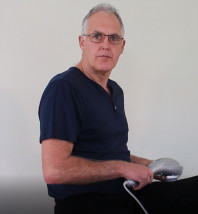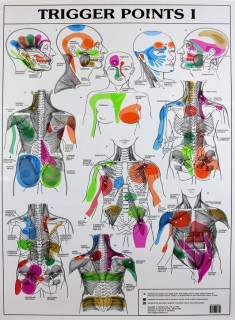How to release (treat) trigger points yourself
Treating or releasing trigger points yourself is actually extremely easy. With a bit of instruction and practice you can easily find the... Read Article

There are a variety of systems of “pressure points” used for health benefits and to relieve pain. They all have their devoted advocates and come with their story about how they work and why they are beneficial. So, if you are looking at this type of care how do you know what the difference is and which you need.
In this article we’ll go over the differences, then give you some guidance to help you work out which is best for you, and as a bonus we’ll show you how to find these points and treat them yourself.
The difference between trigger points, acupressure points and shiatsu
How do you work out which is the best therapy for you
How to treat these pressure points on yourself
Links for various problems that involve trigger points
Professionals
References
To put it simply, trigger points, acupressure (acupuncture) points and shiatsu points come with completely different stories, but the points themselves are about 95% the same (1–6). The easiest way to explain this is that the originators of these systems have found exactly the same problems, but come up with a way to explain them based upon their knowledge at the time.
In the case of acupuncture and shiatsu, these systems were developed by the Chinese and Japanese respectively thousands of years ago when science as we know it did not exist. On the other hand trigger points were identified as abnormal lumps in muscles, then investigated and explained using modern scientific knowledge.
Though the points are similar, differences in the way each system has evolved affects which points they choose and how they are treated.
The practice of acupuncture (acupressure) and shiatsu have evolved using thousands of years of clinical experience. To put it diplomatically, the explanations such as the meridians and so forth are not consistent with science but there is likely some truth in a lot of the relationships between the points and various conditions they are said to fix.
Trigger points have developed from therapists finding abnormal abnormal lumps in muscles, then using scientific methodology to explain them and work out how they can affect your body.
Perhaps the easiest way to explain the differing approaches is to use the example of a common problem: headaches.
Based on thousands of years experience acupressure and shiatsu practitioners know the common points that have been found to help headaches. Based on this they use what amounts to recipe approach. For example, in a trial on acupressure for headaches (7) the therapists pressed on these points: GV20, Ex7, LI4, GB34, ST36, and LI10.
Please note that:
Scientists have investigated which muscles contain trigger points that are able to refer pain to the head. Armed with this list, a trigger point therapist would examine each of the muscles and treat any trigger point he or she found.
Please note that:
When dealing with musculoskeletal pain such as back, neck and shoulder pain it’s no contest. Rather than having a therapist use a canned response of pressing on pre determined points it is much better to have a professional with an excellent knowledge of things like anatomy, physiology and musculoskeletal function to diagnose the problem, work out which muscles may be involved, then examine the muscles and treat what is actually needed.
Please note that most headaches are actually musculoskeletal pains coming from the muscles and joints of your head and neck, so this approach was used in the example above.
As discussed in our article The Health Benefits of Massage general massage and muscular therapy can have some huge benefits for health issues such as improving sleep and reducing blood pressure.
While acupuncture is based on clinical experience gained over thousands of years and may may have identified links between points and health issues, a therapist using using the trigger point approach would investigate the those areas and treat what was actually involved, possibly using better scientifically developed treatments

We will show you the science based trigger point approach. If you do wish to follow the acupressure or or other system of treating pre-determined points you can still use the more "scientific" treatments we will show you.

The technical name for these are Myofascial Trigger Points. They are tender lumps in your muscles that develop slowly over time. At the start you don’t know they are there unless a therapist presses on them (ouch), but if left they can get larger and eventually start shooting pain. Trigger point therapists often have charts like these showing where the points are and the pain they cause. For more information on trigger points please see our article Your complete guide to (myofascial) trigger points
A trigger point therapist will usually use their clinical knowledge including charts like above to zero in on the muscles possibly involved. To help you with this, below we’ve got links to various guides that show you the muscles possibly involve for conditions such as headaches, back pain, shoulder pain, fibromyalgia and more. To find the trigger points in these muscles a therapist will use his or her fingers to examine the muscles for tight bands of muscles and tender lumps. You will find instructions on how to do this in our article How to treat trigger points at home
In our guide How to treat trigger points at home we show you how to use three very effective home trigger point therapies:
Self massage and trigger point therapy for headaches and migraines
Massage and trigger point therapy for low back pain, with self help options
Massage and trigger point therapy for calf pain, with self help options
Massage and trigger point therapy for shoulder pain, with self help options
Self massage and trigger point therapy for tennis elbow
Trigger point therapy for fibromyalgia, inc. self help advice
By far the easiest and most effective way to treat these points is by using a professional standard vibration massager such as our DrGraeme massagers. They were originally built by Dr Graeme for use in his clinic, and to prescribe to his patients for additional self use at home. Now these are used by colleagues and other professionals for similar purposes. If you are a professional and wish to know more about this therapy, or possibly get a sample massager to trial please check out our practitioner page
We are continually adding more information on research and uses. Subscribe below to have us email them to you "hot off the press".

Several years ago Dr Graeme, a Chiropractor practicing in Victoria, Australia was looking for a serious hand held massager his patients could use at home to get the extra quality massage they needed. The ones he found in the shops and on-line for home use looked nice but were not serious, and... read more
Treating or releasing trigger points yourself is actually extremely easy. With a bit of instruction and practice you can easily find the... Read Article
Tennis elbow is a painful condition where prolonged abnormal tension in your forearm muscles causes the site where they are attached to... Read Article
Two of the best studies of shoulder pain found that (myofascial) trigger points in 17 different muscles contribute to shoulder pain... Read Article
Scientists have found that a high proportion of headaches result from pain coming from the muscles and joints of your head and neck. ... Read Article
There are a variety of systems of “pressure points” used for health benefits and to relieve pain. They all have their devoted advocates... Read Article
In this article we will discuss the health and wellness benefits of regular or wellness massages that have been scientifically... Read Article
Trigger points are those tender lumps in muscles that therapists find. This article covers what they are, what they do, and how they are... Read Article
Do not refresh or leave this page until loading complete.